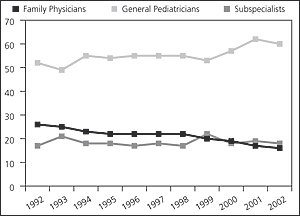
Am Fam Physician. 2006;73(9):1518
Nationwide, family physicians (FPs) deliver a smaller proportion of the outpatient care of children than they did 10 years ago. Millions of children depend on FPs for care. Family medicine should reevaluate how it will contribute to the care of the nation's children.
The proportion of U.S. office visits for children performed by FPs declined between 1992 and 2002 (see accompanying figure1), as did the number of children cared for by FPs,2,3 while the number of children seen in outpatient settings remained stable. From 1981 to 2004, the U.S. pediatrician workforce more than doubled (see accompanying table4) and the U.S. birth rate declined from 15.8 to 14.1 live births per 1,000 persons.2 Growth in the work-force of physicians who care for children will continue to outpace the birth rate for five to 10 years or more. Children in rural and urban underserved areas, meanwhile, remain disproportionately dependent on FPs for their care.2

| Year | Generalist pediatricians | Children (0–17 years) | FPs |
|---|---|---|---|
| 1981 | 20,051 | 63,213,000 | 54,013 |
| 1986 | 24,128 | 62,865,000 | 60,311 |
| 1991 | 30,080 | 65,111,000 | 67,078 |
| 1996 | 35,202 | 70,226,000 | 77,185 |
| 2001 | 41,753 | 72,604,000 | 87,016 |
| 2004 | 45,994 | 73,277,000 | 93,833 |
| Increase | 129% | 16% | 74% |
According to the Future of Family Medicine report,5 most Americans can identify pediatricians as “the doctors who care for children,” whereas the role of FPs is unclear. Facing a shrinking percentage of child visits and an increasingly competitive environment for child health care, family medicine has several choices about its future role in the health care of the nation's children. These include: (1) relinquishing such care and focusing on the increased demands of an aging population, (2) refocusing training of a part of its workforce to meet the continued needs of rural and underserved sites, (3) competing for a shrinking market through new model practice efforts to improve brand recognition and perceived value, and (4) engaging other providers of child health care in collaborative new models of practice that capture the unique features of each provider group and that can care for children in the context of family and community.